(Editor’s note: what follows is a “reprint” of a piece that was originally posted on TheForce.net’s Literature forum in 2012. As such, it may occasionally come across as a conversation-starter more than a standalone work. Comments are welcome both here and in the original discussion thread, where the conversation continues—116 pages and counting as of this writing. – Mike Cooper, 7/8/13)

This won’t be new information for many of you, but now that the new forums are up, I thought the launching of Diversity 2.0, so to speak, would be a good opportunity to sum up the conversation thus far, in particular all of the great statistical work done on the temp boards.
The foundation of this essay, and the ensuing discussion, is the belief that the Star Wars Expanded Universe has a responsibility to present a diverse galaxy of characters, and that with some notable exceptions, this responsibility has been largely neglected.
Following from that are a few more precise assertions:
- There are too many white human men. While passionate and fair arguments can be made for any number of specific “minority” groups being given a larger role–aliens, people of color, women, LGBTQ, the disabled, and so on–the one thing everyone should be able to agree on is that more white human men (hereafter referred to as WHMs), of standard body type and orientation in particular, are helpful to no one, and only by making their long-held “default” status painfully obvious can anyone else hope for a fair shake.
- Ignorance is bias. Which is to say, when presented with a divisive issue, choosing to disregard it still constitutes taking a stand. To ignore race and orientation is itself a biased act, not a neutral one. The images above are of the Jedi Council from Episode I and the leadership of the New Jedi Order as of the early Legacy Era. It is my position that no clearer evidence of a problem exists than in these two images, wherein the WHM ratio is essentially inverted.
- Lastly, it should be understood that this situation stems from the accumulation of numerous decisions, policies, and cultural trends–over a period of decades–and cannnot be laid at the feet of any specific author, editor, or even publisher.
The primary goal of this manifesto is for you, the reader, to look at those two images and see a problem. The goal of this as a discussion thread, then, is to break down the can of worms that follows from that.

 Back in August, Star Wars Insider published the definitive Top 20 memorable moments in all of the Expanded Universe.
Back in August, Star Wars Insider published the definitive Top 20 memorable moments in all of the Expanded Universe.